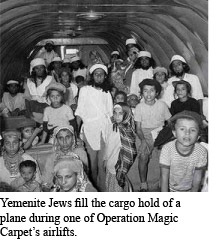THE PLIGHT AND FLIGHT OF THE 850,000 JEWISH REFUGEES FROM ARAB LANDS

There are 25 countries spanning North Africa and the Middle East which are Islamic countries. Even those like Jordan and Egypt which are considered more Western are still ruled by powerful Islamic governments and many of the nations, such as Saudi Arabia and Afghanistan are strictly Islamic. For the Muslim citizens of the country, this means that life is based upon the Sharia laws and punishments for violating prayer times, dress codes and modesty laws can be severe. For the Jews of these countries, life has been consistently hard. Separate laws govern all “Dhimmis” or non-believers in Muslim countries and Jews have been restricted and persecuted for hundreds of years.
The founding of the State of Israel in 1948 and the immediate invasion by the large Arab armies was the trigger that pushed the fragile relationship between Arabs and Jews in Muslim countries to breaking point. However, for the Sephardic Jews living in Arab lands, Israel’s independence meant that there was now a place of refuge. In the decades following the establishment of the State of Israel, over 90% of the Jewish population of Arab countries was able to leave, under various means, to rebuild their lives in the Jewish land.
There has been a Jewish presence in Arab countries across the Middle East and North Africa for over 1,000 years before the existence of Islam. Many were Jewish settlers who had escaped the Babylonian exile after the destruction of the first Temple. Others were merchants and traders who settled in the Fertile Crescent or along the Mediterranean coast. In many areas, Jews made up a sizable part of the population, contributing wealth and culture to society, although they kept to their own groups.
The Jewish presence in Egypt, Syria and Iraq has been confirmed dating back to Biblical times. The Jews of Yemen were noted in Jewish literature as being pious and traditional. Yet throughout their history, there were frequent pogroms, restrictions and edicts that made life close to unbearable for many Jewish communities across the Arab world.
The North African communities of Morocco, Tunisia, Libya and Algeria were among the most vibrant and populous Jewish communities. The numbers had swelled after the Expulsion from Spain and Portugal and by 1940; they numbered over 350,000 Jews in total. Morocco had the most sizable community. There had been many attacks and pogroms over the centuries and most Jews lived in enforced ghettos where life was culturally rich but restricted. Some Jews were very successful, but the heavy taxation and frequent attacks took their toll on the communities. During World War Two, all four of these countries fell under the Fascist regimes of the Nazis or Vichy France. While they escaped the deportations to the concentration camps of Europe, life was still unbearable. The Arabs disseminated Nazi propaganda and spontaneous riots, massacres and humiliations followed.